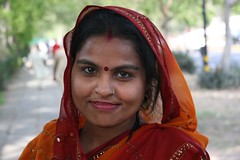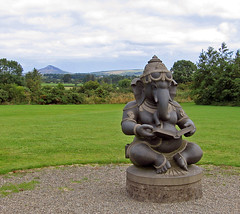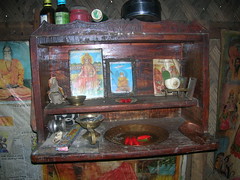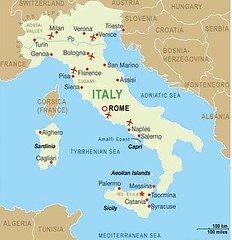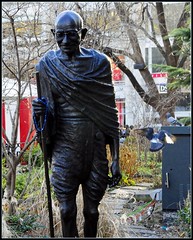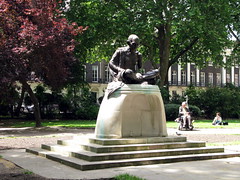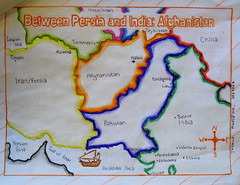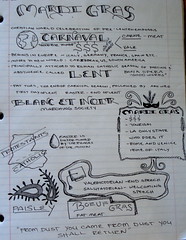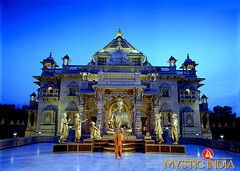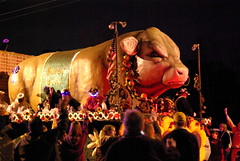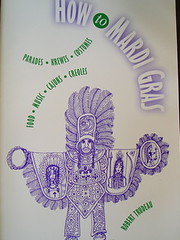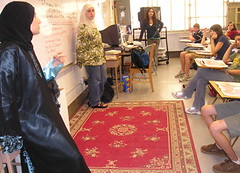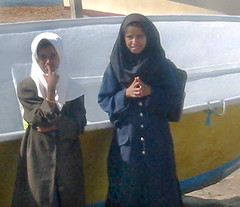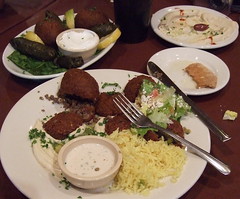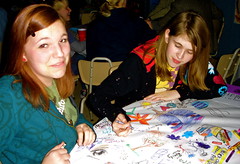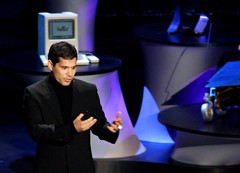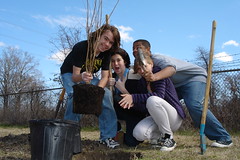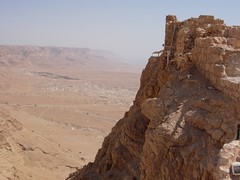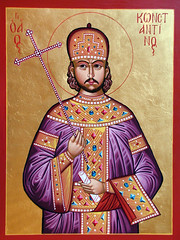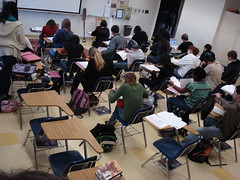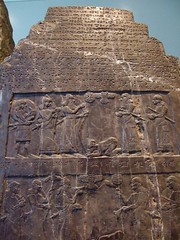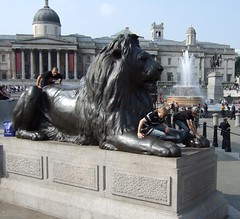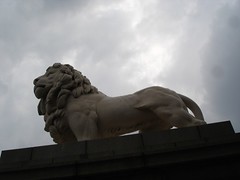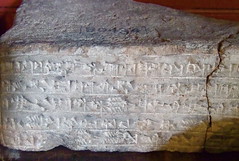Saturday, February 28, 2009
Indie work
- Gandhi and Siddhartha Gautama
- American Revolution against the British and the Independence Movement of India against the British
- Resources: the gem stones of India versus those of South Africa
- The British need for the resources of India and the America need for the resources of the Middle East
Friday, February 27, 2009
You may wear a Bindi if you please
Nowadays, bindis are worn throughout South Asia (India, Bangladesh, Nepal, Sri Lanka, and Pakistan) by women and girls, and no longer signify age, marital status, religious background, or ethnic affiliation.[2] The bindi has become a decorative item and is no longer restricted in colour or shape. Self-adhesive bindis (also known as sticker bindis) are available, usually made of felt or thin metal and adhesive on the other side. These are simple to apply, disposable substitutes for older tilak bindis. Sticker bindis come in many colors, designs, materials, and sizes. Fancier sticker bindis are decorated with sequins, glass beads, or rhinestones.
Lord Ganesh
Devotion to Ganesha is widely diffused and extends to Jains, Buddhists, and beyond India.[8]
Although he is known by many other attributes, Ganesha's elephant head makes him easy to identify.[9] Ganesha is widely revered as the Remover of Obstacles[10] and more generally as Lord of Beginnings and Lord of Obstacles (Vighnesha, Vighneshvara),[11] patron of arts and sciences, and the deva of intellect and wisdom.[12] He is honoured at the start of rituals and ceremonies and invoked as Patron of Letters during writing sessions.
Thursday, February 26, 2009
Hinduism
Hinduism is often referred to as Sanātana Dharma, a Sanskrit phrase meaning "the eternal law", by its practitioners.[2]
Hindu beliefs vary widely, with concepts of God and/or gods ranging from Panentheism, pantheism, monotheism, polytheism, and atheism with Vishnu and Shiva being the most popular deities. Other notable characteristics include a belief in reincarnation and karma, as well as personal duty, or dharma.
Among its roots is the historical Vedic religion of Iron Age India, and as such Hinduism is often stated to be the "oldest religious tradition" or "oldest living major tradition."[3][4][5][6] I
t is formed of diverse traditions and types and has no single founder.[7] Hinduism is the world's third largest religion after Christianity and Islam, with approximately a billion adherents, of whom about 905 million live in India.[8] Other countries with large Hindu populations can be found across southern Asia.
Om
It is placed at the beginning of most Hindu texts as a sacred exclamation to be uttered at the beginning and end of a reading of the Vedas or previously to any prayer or mantra and also is said in the beginning of any puja (religious ritual).
The Sanskrit name for the syllable is praṇava, from a root nu "to shout, sound, praise", verbal pra-nu- being attested as "to make a humming or droning sound" in the Brahmanas, and taking the specific meaning of "to utter the syllable om" in the Chandogya Upanishad and the Shrauta Sutras.
Namaste
It is commonly used in India and Nepal by Hindus, Jains and Buddhists, and many continue to use this outside the Indian subcontinent.
When spoken to another person, it is commonly accompanied by a slight bow made with hands pressed together, palms touching and fingers pointed upwards, in front of the chest. The gesture can also be performed wordlessly and carry the same meaning.
In Indian and Nepali culture, the word is spoken at the beginning of written or verbal communication. However, upon departure the only the wordless hands-folded gesture is made.
In yoga, namasté is said to mean "The light in me honors the light in you," as spoken by both the yoga instructor and yoga students.
Wednesday, February 25, 2009
Who are the Sikhs?

Soldier of Sikh Regiment's Band in Ceremonial Dress, Indian Army
Originally uploaded by Captain Suresh
According to Article I of "Sikh Rehat Maryada" (the Sikh code of conduct & conventions) a Sikh is defined as "any human being who faithfully believes in One Immortal Being; ten Gurus, from Guru Nanak Dev to Sri Guru Gobind Singh; the Sri Guru Granth Sahib; the utterances and teachings of the ten Gurus and the baptism bequeathed by the tenth Guru; and who does not owe allegiance to any other religion".[25]
The greater Punjab region is the historic homeland of Sikhism. Most Sikhs are Punjabis and come from the Punjab region, although significant communities exist around the world. Punjabis and the Punjab region's history has been tremendously important in the formation of Sikhism as a religion.
Review of the movie Ghandi
"Do you fight to change things or do you fight to punish?"
"An eye for an eye only makes the whole world blind."
"If you are a minority of one, the truth is still the truth."
"Poverty is the worst form of violence."
1. The opening scene of the movie is a reenactment of Gandhi’s assassination. State 2 factors that make the murder a surprising one.
2. The next scene takes place in S. Africa when Gandhi was beginning his career as a barrister. What does his experience on the train say about British society?
3. When Gandhi meets with his colleagues in S. Africa he is shocked by the racism. What is Gandhi’s reaction?
4. During Gandhi’s first public meeting, he outlines his methods for fighting an unjust law. What is the outcome of his protest?
5. Gandhi meets a sympathetic English clergyman, and they walk through an impoverished and racist neighborhood. What book does Gandhi quote when they face a group of yahoos?
6. Life in the Gandhi ashram (a Hindi word for community) is an experiment. What is the great social class taboo he believes must be changed?
7. The Christian minister gives a sermon which supports Gandhi and his social protest. What is the reaction of the majority of attendees?
8. Compare the clothing of Gandhi to the dress of the other Indian leaders. What point was being made by Gandhi?
9. Describe the farming system established in India by British colonists.
10. Gandhi tells the American minister that he can do the most good by exiting the protest movement. Why did Gandhi push away this hard-working supporter?
11. Why does General Dyer massacre the gathering of Indian Sikhs in their non-violent meeting?
12. What are Gandhi’s 2 most important goals in building an independent India?
a) Hindu-Muslim unity b) Recognition for the Untouchable caste.
13. What is the purpose of Gandhi’s fast?
Identify the following with a brief phrase or sentence.
14. Kasturba “Ba” Gandhi - the wife and partner of Gandhiji.
15. General Jan Christian Smuts - governor of South Africa during Gandhi's protests.
16. Pandit Nehru - closest to Gandhi of all the Home Rule politicians; he was the first Prime Minister when India became independent.
17. Mohamed Ali Jinnah - Muslim leader in Gandhi's political circle.
18. Margaret Bourke-White - award-winning American photo-journalist and pioneer female photog.
19. Sikh - a religion of India that is blend between Hinduism and Islam and is common to the Punjab region.
20. Bhagavad Gita - an ancient holy book of Hinduism.
21. British Empire - the world's dominant power during the 18th and 19th centuries.
22. Ashram - a community in which a group of people share their resources.
23. Untouchables - the lowest caste of India.
24. Non-violent resistance - used by both Gandhi and MLK, Jr.
25. Indigo - plant that produces a blue dye.
26. Mahatma - "Great soul."
27. Dharasana Salt Works - site of the Salt Tax protest; near Porbandar.
28. Pakistan - nation partitioned from India in 1947 as a haven for Muslims.
29. New Delhi, India, January 30, 1948 - Gandhi's assassination.
30. Why does the director choose to open the biography with Gandhi’s death?
31. What is sedition? calling for the overthrow of a government.
32. As India’s independence becomes imminent, the conflict among Indians increases. What is the cause of the conflict? Hindu vs. Muslim, based on ancient grudges. How does Gandhi suggest resolving this conflict? He asks everyone to pray; to see their neighbors as brothers instead of people divided by religion. He goes on a fast to get everyone's attention.
33. In the 1930’s millions of Indians were unemployed. How did Gandhi protest the system that idled the farmers? - He proposed that Indians wear homespun cloth and use a spinning wheel to make their thread and clothing. In so doing they would boycott the fabric from England.
34. When India gained its independence from Great Britain, who started fighting? Rioting between Hindus and Muslims was widepread.
35. Why did British attempts to control India fail? Though they were successful in controlling India for some 300 years, the British eventually were repelled by Indian non-cooperation.
36. What lessons do you draw from Gandhi's life story?
37. Why did people follow Gandhi despite the difficulties in it?
Gandhi: vocab
- assimilating - blending in with the dominant culture.
- anarchists - radicals who believe that all government is bad and should be eliminated.
- Viceroy - English title for the governor of a colony such as India.
- monsoon - the rainy season.
- jasmine - garlands of jasmine are worn to symbolize joy; are also sweet smeling.
- namaste' - Hindi greeting
- rebate - money given back to you.
- passive resistance - to show your opposition by Not doing something.
- Mahatma - Great soul.
- indigo - plant which produces a blue fabric dye.
- seditious - advocating the overthrow of the government.
Gandhi's goals . . .
1) Hindu-Muslim unity
2) Ending of the caste system - especially of the unfair treatment of the lowest caste, the untouchables.
3) Defying British authority while they continued to control India.
4) Wearing homespun cloth instead of British textiles.
Tuesday, February 24, 2009
Gandhi offers many gifts to the viewer
- cinematography
- videography
- story-telling through images
- biography and literature
- dialogue (through the captions that are on screen each day)
- vocabulary
- history
Spatial changes: a Gandhi map that crosses 3 continents
For 3 pts make a map that shows his residence in
a) Porbandar, India
b) London, England
c) Pretoria, South Africa
Include
- 3 seas
- 3 continents
- title
- rim of color
Notes -
a) symbol of Islam
b) symbol of Hinduism
British Empire was a globe-circling series of possessions.
- the Brits took control of weaker nations so they could make profit of these nations' natural resources, their labor and their markets.
- Brit possessions were on every continent: Europe, Africa, Middle East, Central Asia, East Asia, South America, North America and Central / Caribbean America.
"Home Rule" was the Indian term for independence from British control.
Monday, February 23, 2009
Experiement in learning styles with alternative to memorized map quiz
To get full credit please hit these benchmarks:
- colored borders around nations
- colored border around the map (see above)
- imaginative title
- illustration (ship or castle, etc) and compass rose
- neatness
- principal cities, neatly identified
- bodies of water, too.
- check spelling!
Thanks to Heather Hasson for an excellent example of this alternative.
Artist: Isabelle Vea, Cmhs class of 2012, Shreveport
Hindu temple / Mystic India IMAX film
a) carnival and India
b) map: 10 items on Afghanistan, Pakistan, India
Intro to the map of India -
- New Delhi
- Kolkata
- Mumbai (Bollywood)
- Bangalore (Microsoft, Dell, etc)
- Agra (Taj Mahal)
- Porbandor
- Mt Everest
Himalayas
Pakistan
Nepal
China
Bangladesh
Arabian Sea
Bay of Bengal
Indian ocean
- Democracy
- Impoverished
- Economy growing rapidly
- 1 billion population
- Hindu and Muslim
- MK Gandhi, 1869 - 1948
- Himalayas
Saturday, February 21, 2009
Boeuf gras, Krewe of Centaur, Shreveport
Friday, February 20, 2009
The most comprehensive guide to Louisiana's Carnival season: How To Mardi Gras
Carnaval
Begins in Europe Italy (Roma, Venicia), Germany, Belgium, France, Spain, etc.
Moves to New World along with the Roman Catholic religion: to the Caribbean islands, South America, the US (La and Mobile, Ala).
Carnival and Lent are a Catholic thing. N La is majority Protestant therefore has no direct connection to mardi Gras. Here it's for business, esp tourism.
Lent - fasting, abstinence and bona opera (good works). From Ash
Wed until Holy Week or Easter Sunday.
Fat Tuesday marks the end of Carnival season.
Ash Wed: priest marks parishioners with ashes and says "Remember, man, that from dust you came and to dust you shall return."
Carne: "meat"
vale: "goodbye," or "the end of."
Carnaval: "the end of feasting and partying."
Boeuf gras float: "fatted cow" to be slaughtered for final feast before Lent.
See Valedictorian and Salutatorian.
Blanc et Noir Marching Society: jazz band and New Orleans second line tradition.
Louisiana: triangular southern section is majority Catholic. School holidays!
Thursday, February 19, 2009
Islamic terms from the Osama bio
- jihad - "struggle" or "holy war." a controversial term of variable interpretation.
- Mullah - Islamic leader in matters of theology or the Qur'an,
See the term Imam.
- Usury - loaning money at interest.
- heretics - those against the common teachings.
- hijab - the veil and scarf typically worn by Muslim women.
- burqa - the robe and veil that covers a woman entirely - as used in strict Islamic nations such as Saudi Arabia and Iran.
- al Jazeerah - principal cable news network of the Midddle East.
- age 51 - the prime of a man's life, ordinarily.
Wednesday, February 18, 2009
Indie work: Osama Bin Laden story compared to Mohandas K Gandhi
Since 2001, Osama bin Laden and his organization have been major targets of the United States' War on Terrorism. Bin Laden and fellow Al-Qaeda leaders are believed to be hiding in the border region between Afghanistan and Pakistan, says Wikipedia.
Bin Laden believes that the restoration of Sharia law will set things right in the Muslim world, and that all other ideologies—"pan-Arabism, socialism, communism, democracy"—must be opposed.[21] These beliefs, along with violent expansive jihad, have sometimes been called Qutbism. [22] He believes Afghanistan under the rule of Mullah Omar's Taliban was "the only Islamic country" in the Muslim world.[23] Bin Laden has consistently dwelt on the need for jihad to right what he believes are injustices against Muslims perpetrated by the United States and sometimes by other non-Muslim states,[24] the need to eliminate the state of Israel, and the necessity of forcing the US to withdraw from the Middle East. He has also called on Americans to "reject the immoral acts of fornication (and) homosexuality, intoxicants, gambling, and usury," in an October 2002 letter.[25]
Probably the most controversial part of Bin Laden's ideology is that civilians, including women and children, can be killed in jihad.[26][27] Bin Laden is antisemitic, and has delivered warnings against alleged Jewish conspiracies: "These Jews are masters of usury and leaders in treachery. They will leave you nothing, either in this world or the next."[28] Shia have been listed along with "Heretics, ... America and Israel," as the four principal "enemies of Islam" at ideology classes of bin Laden's Al-Qaeda organization.[29]
Get to Know Your Government ACEOs : The Complete Set
That's how Democracy ought to work.
An alternative to the map quiz: Artful map of Afghanistan and neighbors
There's no easy answer and each student must answer that question for himself, but this is the time of your life to try the options.
An experiment: you may choose to sketch borders and add 6 identifications to the map quiz on
Af ghan i stan
on Thurs or you may choose to do homework of an artful map of the nation and neighbors.
- Title: Between Persia and India: Afghanistan
- colored borders
- nations
- major cities
- compass rose
- simple but decorative border.
- illustrations such as Arab dhow and flag.
Also be ready for a 12-question open notes quiz on the Holy Land similar to the last one we assayed.
- neatness and spelling!
Tuesday, February 17, 2009
Afghanistan and a review of 9-11
Osama bin Laden and most of the assassins were natives of Saudi Arabia. The average American probably thinks they were Afghani because many members of al Qaeda were trained in Afghanistan.
"Then why didn't we attack Saudi Arabia?"
We have an uneasy relationship with Saudi Arabia. The overriding fact is that we need their oil. The fact that al Qaeda got most of its money and philosophical support from Saudi Arabians was an inconvenient truth in the post-9/11 war on terrorism.
"Then why did we attack Iraq?" In my opinion, there's no satisfactory answer to that one aside from faulty intelligence and questionable judgement.
The mountainous, impoverished nation of Afghanistan remains a problem for the US. We used bombs and soldiers to get rid of the Taliban, the radical Muslim leadership group. The radical terrorist group called al Qaeda used this nation as HQ for training.
Subsequently we have tried to rebuild the nation. We have not been terrifically successful. Today, there are reports that the Taliban are again becoming a factor in Afghan life.
Overview of SW Asia
2. This city of the Black Sea was called Byzantium and Constantinople. Today it is a) Athens b) Beirut c) Cairo
d) Istanbul.
3. The capital of Iran is a) Istanbul b) Baghdad c) Tehran
d) Mecca.
4. Shreveport and Baghdad both lie upon latitude 32 degrees. Is that a) north or b) south of the equator?
5. Which terrorist group was directly responsible for the 9-11-01 attacks on the WTC and Pentagon? a) al Qaeda
b) Taliban c) Iraquis under Saddam Hussein.
6. City known as a French-influenced liberal Muslim tourist center on the Mediterranean:
a) Cairo b) Beirut c) Jerusalem d) Damascus
7. Name the small Egyptian municipality with an enormous and ancient tourist attraction. a) Cairo b) Alexandria c) Jerusalem d) Giza.
8. Minarets are towers that are built alongside a mosque and from which Muslims are called to prayer. The person who chants the prayer is called . . . a) Jihad b) minbar c) Muslim d) muezzin.
9. The terrorists of 9/11/01 were mostly from Egypt and mostly ill-educated family men. T / F
10. Location of the World Trade Center: a) Upper Brooklyn c) Lower Queens d) Upper Bronx d) Lower Manhattan.
11. The rebaba is a Middle eastern instrument of this type: a) drum b) tambourine c) fiddle d) lute.
12. Steve Irwin resided near a) Sydney b) Brisbane
c) Perth d) Cairns
13. Irwin’s death occurred in the a) Indian Ocean b) Pacific
c) Atlantic.
14. Nickname for Australians: a) Kiwis b) Ulurus
c) Digeridoos d) Ozzies.
15. Great Barrier Reef is made of: a) coral b) algae
c) seaweeds d) volcanic rock.
16. The most authentic of digeridoo players: a) diggers
b) Aussies c) aborigines d) Outbackers.
17. The loaf-like mountain in the central region of Australia: a) Outback b) Gold Coast c) Uluru d) Blue Mountains.
18. Major city that lies quite close to 30N, 30E: a) Jerusalem b) Cairo c) Beirut d) Istanbul.
19. Saudi Arabia, principally a vast desert, has no major bodies of water and one range of Western mountains.
T / F
20. Based on terrain, name the nation that will have the most rainfall: a) Oman b) UAE c) Kuwait d) Yemen.
21. The root word for the name Australia refers to a direction, which is a) north b) east c) west d) south.
The following questions will be answered by choosing:
a) Judaism b) Christianity c) Islam d) Hinduism.
22. The Western wall in Jerusalem, or “wailing wall,” is part of the ancient temple which was sacred to the __.
23. Developed some 600 years after the time of Christ: __.
24. Daily prayer, charity, belief in one god, fasting during Ramadan, the hajj: __.
25. The Bible contains a direct link to the religion called ___ , which preceded Christianity.
26. Origin of this religion is around 1000 BC: __.
27. The Torah is a holy book in __.
28. Belief in a single, all-powerful god: a) Islam b) Christianity c) Judaism d) monotheism.
29. A mosque’s tower is called: a) muezzin b) torah
c) Arabesque d) minaret.
30. Rank these nations in oil reserves based on the p. 432 symbols in World Geography (Prentice Hall):
a) Saudi Arabia, Iraq, Iran b) Iraq, Saudi Arabia, UAE
c) Iran, Kuwait, Oman d) Saudi Arabia, Iran, Kuwait.
Monday, February 16, 2009
Kibbe, felafel, dolmas, tzatziki, hummus, etc at Mona's cafe, Shreveport
Mona's Cafe and Al Basha are both Mediterranean restaurants. Al Basha in English means The Man. Both of these restaurants have foods from different cultures including Lebanese and Greek.
Al Basha is just a restaurant while Mona's is a restaurant and has a little store in the back. Some foods from both of these restaurants include hummus, shish kabob, rolled grape leaves, falafel (which is one of my favorite dishes), and lamb kabob.
One interesting drink that is at both of these restaurants is Lebanese Iced Tea. In this drink there is orange blossom water and pine nuts.
The little market in the back of Mona's Cafe is great supplier of a lot of the foods used in my family including olives, olive oil, arabic bread, special cheese, and chick peas (garbanzo beans). Some of the desserts at these restaurants include baklava and mammoul cookies.
In conclusion, Mona's Cafe and Al Basha are both great restaurants that my family goes to, to enjoy a wonderful meal.
Friday, February 13, 2009
More indie work: writing about eating out or writing about attending plays & movies
Any Mediterranean restaurant, examples being -
- Yeero Yeero
- Mona's
- Jerusalem in Bossier (new and recommended by student Mojdeh Efatien)
- Shakespearean or plays by other authors
- Geographic-minded movies such as Slumdog Millionaire (while violent at times, I thought it was acceptable for the average 14 year-old).
- Topics such as the tragedy of Masada compared to the mass suicide that ocurred under quasi-evangelist Jim Jones.
Indie work: comparison of Shai Agassi and Steve Jobs
Steve Jobs is a hero of American technology; his company created the iPod, iMac and iPhone. Though facing health issues today, he has won fame as the successful founder and leader of Apple Computers.
Compare and synthesize their stories.
Flash: in reading the Jobs bio in Wikiepdia I found he was adopted by the Jobs family. But he knows his parents and evidently they are a woman of Jewish background and an Arab fellow, Joanne Carole Schieble and Abdulfattah Jandali.
Jerusalem & Israel Quiz / the post-quiz material
2. c
3. F
4. a
5. d
6. d
7. a
8. a
9. a
10. a
11. c
12. c
13. a
14. d
15. b
16. a
Thursday, February 12, 2009
Jerusalem & Israel quiz
1. The region that we’re studying has a great rift - a crack in the earth’s crust. What would be the geographical evidence of this rift valley? a) Mediterranean coastline
b) border between Israel & Egypt c) River Jordan d) border between Israel & Lebanon.
2. Jerusalem and Natchitoches, La, have something in common. a) meat pies b) longitude c) latitude d) climate.
3. Jerusalem is, contrary to popular belief, not one of the oldest cities in the world. T / F
4. Jerusalem is considered the third-holiest city of the
a) Muslims b) Jews c) Christians d) Buddhists.
5. The status of ___ remains one of the core issues in the Israeli-Palestinian conflict. a) the Dead Sea b) the Mediterranean c) Jordan d) Jerusalem.
6. The Roman emperor Constantine was associated with
a) Israel b) Dome of the Rock mosque c) ancient Jewish Temple d) Church of the Holy Sepulchre.
7. One of these Biblical municipalities is north of the disputed West Bank region. a) Nazareth b) Bethlehem c) Jericho d) Gaza.
8. Palestinians are like Israelis in their connection to
a) Abraham b) King David c) Muhammed the prophet d) Hebrew.
9. Jews who are passionate about having Israel as their homeland may be called a) Zionists b) Palestinians c) Arabs d) Muslims.
10. Born as a modern nation some 60 years ago: a) Israel
b) Palestine c) Jerusalem d) Lebanon.
11. The Jewish diaspora - mostly to Europe - took place because of harsh treatment of the Jews by the a) Egyptians b) Italians c) Romans d) Syrians.
12. The structure built at the terminus (end) of the Via Dolorosa: a) Dome of the Rock b) Temple Mount c) Church of the Holy Sepulchre d) Western Wall.
13. Built at the site of Muhammed’s ascension to heaven and the site of Abraham’s sacrifice of his son: a) Dome of the Rock b) Temple Mount c) Church of the Holy Sepulchre d) Western Wall.
14. Both Judaism and Islam look to __ as their founder. a) Isaac b) Ishmael c) Moses d) Abraham.
15. The population density of Louisiana as compared to Israel: it is much a) higher b) lower c) the same.
16. The lower half of Israel is composed largely of a) desert b) numerous ancient towns c) resort developments d) oases and irrigation systems.
Wednesday, February 11, 2009
The wandering Jew: a story of the Jewish disapora
These refugees have caused never-ending problems for Israel.
The Jews originated in Palestine, parts of which were in ancient times called
a) Judah
b) Canaan
c) Zion and
d) Israel.
Why was it that Jews were returning to re-establish their homeland?
The conquerors of Palestine such as the Romans and the Persians were cruel to the Jews because the Jews were too independent to be fully obedient citizens. These conquerors retaliated against Jewish defiance by burning and otherwise destroying Jewish centers.
Masada: on a mesa in the rocky badlands of Israel were a Jewish group called the Zealots. They defied the Romans from their mountain stronghold, confident that no one could successfully attack them. But the Roman army besieged them. Cut off from food and water, the Zealots (the word zealous means "having great energy to accomplish a task") did not want to fall into the hands of the Romans, though they faced defeat. They instead burned their fortress and committed mass suicide. Some 936 went to their death rather than face torture
or slavery under the Romans.
For centuries the Jewish people were called Wandering Jews. They left Palestine in a great diaspora, or dsipersal. They migrated to many nations in Europe. Large numbers of Jews lived in Russia, Poland, Germany, France and Spain.
Jews typically lived in the least-desirable part of town. The Italian term for the Jewish Quarter was ghetto.
Jews loaned money and were the first bankers and pawn shop operators. In the Medieval era it was a a sin for Christians to loan money at interest. It was called usury. Jews were important to the businessmen of the city even though the Jew was mostly thought of as an alien.
Many Jews were not interested in assimilating into Western/Christian society. They were happy being outsiders.
The Holy Land Project / Google doc presentation

Assemble images in Google Docs under Presentation. Use large images - no less than 350X350.
- 12 images with
- 2 brief on-screen identifications for each image (changed to 2 from the earlier 3);
- and documentation plus titling.
1.Israel
2. Old City of Jerusalem
3. Church of the Holy Sepulcher
4. Via Dolorosa
5. Dome of the Rock mosque
6. Western wall of the ancient Jewish temple - Wailing Wall
7. Tel Aviv
8. Dead Sea
9. Negev Desert
10. Bethlehem or Nazareth or Sea of Gallilee
11. Palestinian
12. Mediterranean meal
Substitutions can be made to acccomodate special finds.
Tuesday, February 10, 2009
Map in the RMQRWA, p. 25.
Ancient Palestine, Modern Israel
Jerusalem
Mediterranean
Dead Sea
Jordan River
Sea of Gallilee
Lebanon
Syria
Jordan
Egypt
West Bank region (disputed)
Nazareth
Bethlehem
Jew vs. Palestinian Muslim Arab
- cousins in blood, language and heritage
- Hebrew & Arabic
- struggle for control of the land of Israel and city of Jerusalem - which has been going on since the Crusades, in the Medieval era.
The Jew vs Palestinian Arab skit:
a) Zionists are Jews who believe that a Jewish homeland in their ancient home of Palestine is important. In the late 1880's and early 1900's they gather funds and purchase land in Palestine.
b) Ottoman Turks owned the land of Palestine. They acquired it when they had a powerful empire. Jews purchase the land cheaply.
c) Palestinian Arabs were mostly shepherds and had overgrazed the land; palestine had become a dry, rocky place early in the 20th century. Jews promises when they got the land they will "Make the deserts bloom." They will use scientific farming to change the terrain.
d) The struggle between those who owned the land by virtue of their long residency and those who purchased it in the modern way is not easily solved. Jews push the Arabs. The Arabs fight back. The Jewish forces ovewhwelm the Arabs.
e) In 1947 the victory of the Jewish forces is complete. They declare a Jewish state to be called Israel.
f) Israel has continually fought to maintain its existence. Its army is called the strongest force in the Mid East. Its principal support - due to lobbying of the US Congress - is foreign aid from the US.
g) The Palestinians have fought back via the intifadeh. That term means a low-cost, terror-based rebellion against the well-equipped Jewish forces. The struggle - which includes suicide bombers - has focused on Gaza and the West bank region.
- Israel's population is not shrinking. They are up from 6 million to 7.3 million. The population comprises some 20% Arab people.
- Israel is a high-tech nation which might go to all-electric vehicles if the Better Place program, founded by Shai Agassi, is successful.
Monday, February 09, 2009
St. Constantine the Great and the Christiqan church and Jerusalem
His mother was St Helena, a convert to Christianity who built the Church of the Holy Sepulchre over the site of Jesus' crucifixion and burial.
Constantine left Rome and ruled the empire from the city of Byzantium, a metropolis he renamed Constantinople.

Jerusalem (Hebrew: יְרוּשָׁלַיִם ![]() (audio) (help·info), Yerushaláyim; Arabic: القُدس
(audio) (help·info), Yerushaláyim; Arabic: القُدس ![]() (audio) (help·info), al-Quds)[ii] is the capital[iii] of Israel and its largest city[2] in both population and area,[3] with a population of 747,600 residents over an area of 125.1 square kilometres (48.3 sq mi) if disputed East Jerusalem is included.[1][4][iv] Located in the Judean Mountains, between the Mediterranean Sea and the northern tip of the Dead Sea, modern Jerusalem has grown up outside the Old City, says Wikipedia.
(audio) (help·info), al-Quds)[ii] is the capital[iii] of Israel and its largest city[2] in both population and area,[3] with a population of 747,600 residents over an area of 125.1 square kilometres (48.3 sq mi) if disputed East Jerusalem is included.[1][4][iv] Located in the Judean Mountains, between the Mediterranean Sea and the northern tip of the Dead Sea, modern Jerusalem has grown up outside the Old City, says Wikipedia.
The city has a history that goes back to the 4th millennium BCE, making it one of the oldest cities in the world.[5] Jerusalem has been the holiest city in Judaism and the spiritual center of the Jewish people since the 10th century BCE,[6] contains a number of significant ancient Christian sites, and is considered the third-holiest city in Islam.[7] Despite having an area of only 0.9 square kilometer (0.35 square mile),[8] the Old City is home to sites of key religious importance, among them the Temple Mount, the Western Wall, the Church of the Holy Sepulchre, the Dome of the Rock and al-Aqsa Mosque. The old walled city, a World Heritage site, has been traditionally divided into four quarters, although the names used today — the Armenian, Christian, Jewish, and Muslim Quarters — were introduced in the early 19th century.[9] The Old City was nominated for inclusion on the List of World Heritage Sites in danger by Jordan in 1982.[10] In the course of its history, Jerusalem has been destroyed twice, besieged 23 times, attacked 52 times, and captured and recaptured 44 times.[11]
Today, the status of Jerusalem remains one of the core issues in the Israeli-Palestinian conflict. Israel's annexation of East Jerusalem has been repeatedly condemned by the United Nations and related bodies,[12][13] and Arab Palestinians foresee East Jerusalem as the capital of their future state.[14][15] In the wake of United Nations Security Council Resolution 478 (passed in 1980), most foreign embassies moved out of Jerusalem, although some countries, such as the United States, still own land in the city and pledge to return their embassies once political agreements warrant the move.[16]
Jerusalem and the Holy Land: sacred to 3 religions

The Holy Land (Arabic: الأرض المقدسة, al-Arḍ ul-Muqaddasah; Ancient Aramaic: ארעא קדישא Ar'a Qaddisha; Hebrew: ארץ הקודש Erets HaQodesh; Greek: Άγιοι Τόποι Agioi Topoi; Latin:Terrae Sanctae), generally refers to the geographical region of the Levant called Land of Canaan or Land of Israel in the Bible, and constitutes the Promised land, says Wikipedia. This area, or sites within it, hold significant religious importance to at least four monotheistic Abrahamic religions: Judaism, Christianity, Islam and Bahá'í. Part of its sanctity stems from the religious significance of Jerusalem, the holiest city to Judaism and third-holiest to Islam.
The holiness of this land was the ideological driving force behind the Crusaders' re-conquest from the Muslim rulers who controlled it since the Islamic conquests. Numerous pilgrims visited that land throughout history.
Although the Zionism movement, the current State of Israel and the Israeli-Arab conflict are largely political, the dispute around the control of the Temple Mount in East Jerusalem is based on religious beliefs. Some have proposed the founding of a Federal Republic of the Holy Land as a one-state solution to the Israeli-Palestinian conflict.[1]
Israelite kingdoms and states existed intermittently in the region for over a millennium, with Jerusalem as their capital. Following foreign conquests, Israelite presence in the Holy Land dwindled. In particular, the failure of the Bar Kokhba Revolt against the Roman Empire resulted in widescale expulsion of Jerusalemites. The Romans renamed this land Syria Palaestina, the origin of the name Palestine. Jerusalem was renamed Aelia Capitolina. The Mishnah and Jerusalem Talmud, two of Judaism's most important religious texts, were composed in the region during this period.
Jerusalem appears 669 times in the Hebrew Bible. Zion, which usually means Jerusalem, sometimes the Land of Israel, appears 154 times. In the first sections, the area of Jerusalem is called Mount Moriah, the location of the binding of Isaac, now called the Temple Mount.
In the Hebrew Bible, Jerusalem and the Holy Land are considered a divine gift, part of several covenants. Jerusalem has long been embedded into Jewish religious consciousness. Jews have studied and personalized the struggle by King David to capture Jerusalem and his desire to build the Jewish temple there, as described in the Book of Samuel and the Book of Psalms. Many of King David's yearnings about Jerusalem have been adapted into popular prayers and songs. Jerusalem is mentioned in many Jewish prayers; the Passover seder prayer ends with Next year in Jerusalem. Jews turn towards Jerusalem to pray. The Western Wall of the Temple Mount, nicknamed the "wailing wall", is the holiest site to Jews and a site of pilgrimage for centuries.
The Holy Land is significant in Christianity, mainly because it is the place of birth, ministry, Crucifixion and Resurrection of Jesus of Nazareth, the Saviour or Messiah to Christianity.
Holy cities for Christians of all denominations:
- Jerusalem is believed to be the site of some of Jesus's teaching, the Last Supper, the subsequent institution of the Holy Eucharist as well as His entombment; Christians believe He was crucified on a nearby hill, Golgotha (sometimes called Calvary). It contains the Church of the Holy Sepulchre and the Church of All Nations.
- Bethlehem is the birthplace of Jesus.
- Nazareth is Jesus's hometown and the site of many holy places, including the Church of the Basilica of the Annunciation and Mary's Well.
Sharing similar religious beliefs with Jews and Christians, Muslims consider the land west of (but not limited to) the Jordan River to be sacred, as mentioned in the Qur'an.
| “ | " Moses said unto his people, 'O my people, enter the Holy Land, which Allah hath decreed you.' " - (Qur'an 5:21) | ” |
The first few months of Islamic history saw the Al-Aqsa Mosque in Jerusalem to be the first Qibla (direction of prayer), as opposed to the Kaaba in Makkah. Both Jerusalem and the Al-Aqsa Mosque, are considered to be the third holiest places for all denominations of Islam. In Arabic, the city of Jerusalem is commonly known as "al-Quds", meaning "the Holy".
Muslims believe that Muhammad journeyed from Masjidul Haram in Makkah, to the Al-Aqsa Mosque in Jerusalem, and back, all in a single night. It was at the Al-Aqsa Mosque that Muhammad performed Salah (the prayers) with all of the Prophets of Islam, and thereafter ascended to heaven, called Mi'raj.
Muslims also consider the depression below Mount Sinai, known as "Tuwa", to be sacred as mentioned in the Qur'an as the "Holy Valley" (الوادي المقدس):
| “ | " Has not there come to you the story of Moses? How his Lord called him in the the holy valley of Tuwa " - (Qur'an 79:15-16) | ” |
Sunday, February 08, 2009
Indie work: comparison of the life of King David of the Jews and the prophet Muhammed, founder of Islam
Certainly they are not held in equivalent status by believers, so I don't want to subtly create offense. Academically, this reading is designed to examine power and personalities in the ancient cultural confluence of the Middle East, more properly called Southwest Asia. .
Read, research, write and meditate.
Friday, February 06, 2009
Don't forget your Shovel for the crepe myrtle planting on Fri
Additional shovels: 2 pts each.
Buckets and parents welcome, too.
Tuesday, February 03, 2009
Mesopotamia / Iraq: hand-sketched map quiz Thurs
- 10 identifications
- borders denoting the nations (may be blocky or blobby but must be in correct relationship)
- spelling
- legibility
1. Euphrates
2. Tigris
3. Baghdad
4. Persian Gulf
5. Iran (Persia)
6. Syria
7. Turkey
8. Jordan
9. Saudi Arabia
10. Kuwait
Mandatory is that the center of the map is identified as Mesopotamia / Iraq.
15 pts.
Lawrence of Arabia Quiz / with answers
1. The dates of WWI were 1914 - 1918. The US entered the war one year after the fighting in Europe had begun. The US began fighting in 1915. T / F
2. Lawrence grew up in the English county of a) Derbyshire b) Worcestershire c) Yorkshire d) Oxfordshire.
3. In the WWI era in Arabia the Middle Eastern conflict was between the nomadic, tribal ___ peoples and the Turks, rulers of the Turkish Ottoman Empire. a) Bedouin b) Muslim c) Persian d) Egyptian.
4. The Arabic word for a canyon, usually a dry, rocky area between mesas, is “___.” a) Guinea b) Ponzi c) Wadi d) Wog.
5. Salaam aleikum translates from Arabic into English as a) "Peace be with you” b) “If God wills it so.” c) “God is great; God is good.” d) the holy Qu’ran.
6. Monte Carlo is the capital city of the nation of a) Monticello b) Monaco c) Andorra d) Leichtenstein.
7. “Recite, then, as much as may be easy for you and seek ye the forgiveness of God. Verily, God is forgiving, merciful ...” These are the opening words of the a) Bible
b) Quran c) Baghavad Gita d) Aqaba.
8. The capital of Syria: a) Mecca b) Damascus c) Jerusalem .
9. The Islamic golden age lasted from about a) 750 to 1050 AD b) 1050 to 1500 AD c) 1500 to 1650 AD.
10. The first outside force to travel to West Africa in order to trade for gold, ivory and slaves: a) Europeans b) Arabs c) Hindus d) Swahilis.
11. The date palm is the principal tree in a desert ___. a) aquifer b) oasis c) wadi d) well.
12. British gold coin: a) Shilling b) Guinea c) Shekel d) Riyal.
13. A concord between major nations that establishes guidelines for treatment of prisoners and for ethical warfare was agreed to at a) Versailles b) Paris c) Geneva
d) London.
From Wikipedia’s biography of TE Lawrence:
Lawrence continued making trips to the Middle East as a field archaeologist until the outbreak of World War I. In January 1914, Woolley and Lawrence were co-opted by the British military as an archaeological smokescreen for a British military survey of the Negev Desert. They were funded by the Palestine Exploration Fund to search for an area referred to in the Bible as the "Wilderness of Zin"; along the way, they undertook an archaeological survey of the Negev Desert. The Negev was of strategic importance, as it would have to be crossed by any Ottoman army attacking Egypt in the event of war. Woolley and Lawrence subsequently published a report of the expedition's archaeological findings,[9] but a more important result was an updated mapping of the area, with special attention to features of military relevance such as water sources. Lawrence also visited Aqaba and Petra.
14. It seems that Lawrence indirectly worked for the British army prior to officially joining the British army. T / F
15. The Negev desert was part of Palestine in 1914. Today the nation of Palestine is called a) Israel b) Aqaba c) Petra d) Egypt.
16. The desert feature of greatest importance to the British in regards the Negev was its a) archaeology b) Ottomans c) water sources d) updated mapping.
1. false
2. d
3. a
4. c
5. a
6. b
7. b
8. b
9. a
10. b
11. b
12. b
13. c
14. t
15. a
16. c
Review of Mesopotamia / Open notes & map quiz Thurs
Choose from a) Iraq b) Iran c) Saudi Arabia d) Kuwait.
1. Tigris
2. Mesopotamia
3. Ur
4. Babylon
5. Baghdad
6. Nefud desert
7. Abraham
8. Euphrates
9. Fertile Crescent
10. cuneiform writing
11. Abraham the Patriarch is considered Father of the Jews. T / F
12. Abraham is also considered Father of the Muslims.
T / F
13. Who came first, chronologically? a) Jesus of Nazareth or b) Muhammad, prophet of Islam.
14. Which is on the west? a) Tigris b) Euphrates.
15. The Tigris & Euphrates flow into the a) Persian Gulf
b) Mediterranean c) Red Sea d) Arabian Sea.
16. In Mesopotamia about 4000 BC scientists find the birth of __ writing. a) hieroglyphic b) cuneiform.
Mesopotamia hand-sketched map quiz on Thurs
- 10 items surrounding and including the Tigris & Euphrates rivers.
Answers:
1. Iraq
2. Iraq
3. Iraq
4. Iraq
5. Iraq
6. Saudi Arabia
7. Iraq (his birth)
8. Iraq
9. Iraq
10. Iraq
11. T
12. T
13. a
14. b
15. a
16. b
Monday, February 02, 2009
YA author Alan Gratz speaks Thur, Feb 5, 6:30 pm, at Cmhs in Mary Jane Malone Lecture Series
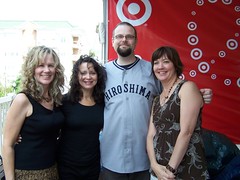
at decatur book festival with vicky alvear schector, alan gratz, lynne culllen
Originally uploaded by Susan Rosson Spain
Gratz is the author of one of the American Library Association's 2007 Top Ten Best Books for Young Adults, Samuari Shortstop, and a 2008 ALA Quick Pick for Young Adult Readers, Something Rotten. A sequel, Something Wicked was released this past fall. A fourth book, The Brooklyn Nine will be released in March.
Adds Clements, "An incredibly delightful gentleman, he has taught middle-schoolers (bless his heart!), written over 6000 radio commercials, and written a few episodes of A&E's City Confidential. Though a native of Knoxville, TN, he now lives with his wife and daughter in North Carolina."
On Thursday, February 5th, at 6:30 in the Performing Arts Center on the Magnet High campus, Mr. Gratz will give a free and open to the public lecture. His books will be available for sale in the foyer both before and after the lecture. Following the evening's lecture, hewill hold a book signing until approximately 8:00 PM.
He will speak to students at 1:30 pm.
Ten points bonus per shovel: Cmhs planting by Class of 2012 on Fri, Feb 6, during social studies classes
Shovels brought from home - on a one-day loan - offer the key to completing the project, says Trudeau. "My students can earn 10 pts indie work credit for bringing a shovel to school for the project. We will label the shovel and after the planting it is Extremely important that each student Bring the Shovel Back to the House."
Cmhs parents Barbara Meyers, Linda Kinnebrew and Renee Young have managed the project. Planting will be done on the north and south sides of E wing.
Comparison project: the achievements of Egypt in parallel with the accomplishments of Mesopotamia - Sumeria, Babylon and Assyria
Among the topics to be addressed:
- architecture
- law
- mythology
- economy
- mathematics & astronomy
- language & writing
Use at least one illustration for each culture.
8 pts.
Sunday, February 01, 2009
Indie work: compare Sumerian & Babylonian cuneiform writing to Egyptian hieroglyphics
- Sumerian and Babylonian cuneiform
- Egyptian hieroglyphics
- Chinese hieroglyphics
Read. Research. Compare. Document.

